St Cuthbert's Church, Edinburgh
| The Parish Church of St Cuthbert, Edinburgh | |
|---|---|
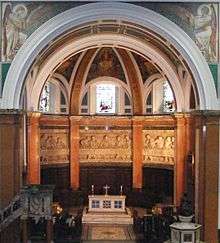 | |
| Denomination | Church of Scotland (Presbyterian) |
| Website |
www |
| History | |
| Dedication | Cuthbert |
| Dedicated | 11 July 1894 |
| Administration | |
| Presbytery | Presbytery of Edinburgh |
| Clergy | |
| Minister(s) |
Revd John Cowie Interim Moderator Revd Suzie Stark Locum Minister Revd Charles Robertson Minister |
| Laity | |
| Organist(s) |
Mr Graham Maclagan Director of Music |

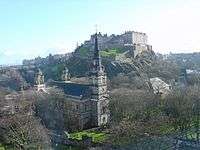
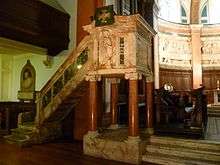
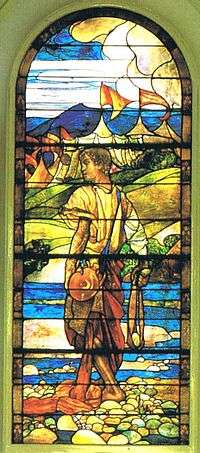
The Parish Church of St Cuthbert is a parish church of the Church of Scotland now within the Presbytery of Edinburgh. The church building is situated east of Lothian Road in central Edinburgh at the western foot of the Castle Rock, at the west end of Princes Street, but set well below street level, unlike its more modern counterpart, St John's, which screens the church in views from the north. The church is surrounded by its churchyard, which adds a valued green space in the city centre, linking visually to Princes Street Gardens on its east side.
History
A chapel dedicated to St Cuthbert is first mentioned in the 8th century. It is believed a church has definitely stood on the same site as currently used since 850 AD, making it Edinburgh's oldest building in terms of foundation. A mediaeval St. Cuthbert's church is mentioned in 1127 (possibly rededicated by St. Margaret). Early maps showing the church usually refer to it simply as West Church.[1]
The parish boundaries of the church were somewhat eccentric, encompassing outlying villages such as Stockbridge and Canongate (originally a separate burgh distinct from Edinburgh) but oddly also taking in Edinburgh Castle (resulting in many soldier burials over the centuries). After the Scottish Reformation the long nave, with a staged tower in its south flank, became the 'Little Kirk', and the choir was submerged in a mass of additions of which one – the Nisbet of Dean vault of 1692 – survives on the north side.
In 1754 a Chapel of Ease was proposed for the South side of the parish, and approved by the Kirk Session. This chapel was opened in 1756 and accommodated 1200 people, having cost £640 and 10 shillings to construct.[2] It was later renamed Buccleuch Parish Church and is sited at 33 Chapel Street, not far from the Old College of the University of Edinburgh.[3] The building was remodelled and extended in 1866. The church closed in 1969, and having been used by the University of Edinburgh for storage for 40 years[4] it was sold to the Greek Orthodox Church and is due to reopen in 2015.[5]
Eighteenth-century maps show a West Church Poorhouse immediately west of the church.[1]
By 1772 St. Cuthbert's kirk was structurally dangerous, and in 1773–1775 (following a competition) the architect-builder James Weir, of Tollcross, built a preaching box with two tiers of galleries reached by stairs in the pedimented western projection.
Between 1787 and 1790 the ground to the north of the church was drained for an extension of the burial ground, and in 1789–1790 Alexander Stevens built the spire which he probably designed himself. By 1888 the church had become unsafe, and Hippolyte Blanc was appointed as architect to address the situation. He first proposed to recase it, but eventually a rebuild was decided upon, maintaining the general proportions but greatly increasing the size. The result, with a pair of Baroque towers flanking the domed apse at the east end, is best seen from the lower level of Princes Street Gardens. In 1893 the Kirk Session decided upon 'a general and harmonious scheme of scriptural subjects applying to the stained glass windows of the whole church', not often seen in Church of Scotland kirks. These were executed, again a departure for Presbyterianism, in early Renaissance tabernacle frames almost all from the same firm, Ballantyne & Gardiner. The notable exception is the window depicting David going out to meet Goliath, which is by Tiffany Glass Company of New York City (after 1900), one of only two or three Tiffany windows in the UK.
The architecture and, especially the interior decoration of the current church building is very unusual in a Presbyterian Church, especially of this period. It is particularly ornate, reflecting the influence of the 'Scoto-catholic' movement and many influences more associated with Roman Catholicism and the ‘Tractarian’ movement within Anglicanism. As a result, the building proved very controversial in its initial period, occasioning comment in both national newspapers and at the General Assembly of the Church of Scotland.
War Memorials
Parishioners lost in World War I are remembered in the very fine War Memorial Chapel, on the south-west corner of the church. It has a wholly different atmosphere from the remainder of the church, being very small and intimate. It is occasionally used for services when congregation numbers are small. The stained glass here is by Douglas Strachan.[6]
The memorial to parishioners lost in World War II is found around the doors from the main church into the outer hall.
The Churchyard
The original burial ground was restricted to an area to the south-west, now a small mound in relation to the rest of the churchyard. This was latterly known as the "Bairns' Knowe" (children's hill) as it was often used for burial of children. Records show that this was open to the countryside until 1597, and sheep and horses would graze here. A wall was then built around the churchyard.[7]
In 1701 ground was added to the west and north-west, concurrent with a refurbishment of the church, which is recorded as having been somewhat derelict since the period of the English Civil War.[7]
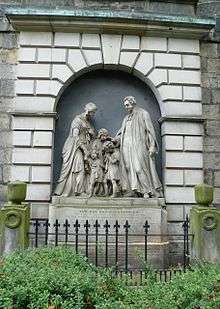
In 1787 the north marsh (at the west end of what was then the Nor' Loch was drained, immediately north of the church, to expand the area for burial. A little later the ground to the south-east was raised to drier levels and enclosed on its east side by a new wall.
In 1827 the watchtower to the south-west was built to defend against grave robbing which was rife at that time.
In 1831 the manse (to the south) was demolished, and a new manse and garden built further south.
In 1841 a railway tunnel was built under a new southern section of the graveyard, dating from only 1834, to serve incoming trains to the new Waverley Station. Many graves had to be moved as a result of this. Stones from between 1834 and 1841 in this section have been totally lost or destroyed.
In 1863 the entire churchyard was closed under order of the newly appointed Medical Officer of Health, the graveyard being then considered "completely full". The church, however, refused to cease burial, considering a viable and important source of income. In 1873 the church, in a rare event, was taken to court for "permitting a nuisance to exist (as defined) under the Public Health Act 1867, being offensive and injurious to health". This still did not effect closure. In 1874 they were ordered to close by the Council (then known as the City Corporation) but only did so after a year of further appeals.[7]
The churchyard is impressive, containing hundreds of monuments worthy of notice, including one to John Grant of Kilgraston (near Perth), and a three-bay Gothic mausoleum of the Gordons of Cluny by David Bryce.
One feature of oddness is at the west side of the churchyard, where Lothian Road has been widened over the churchyard (in 1930) by the City Architect, Ebenezer James MacRae, but due to its greater height over the churchyard, has been done so on pillars, so the graves still remain beneath the road surface. The eastern pavement therefore traverses these graves.
Noteworthy burials
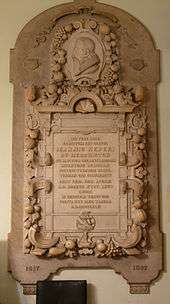
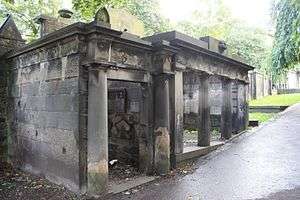
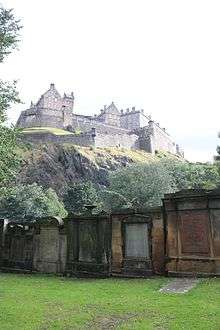
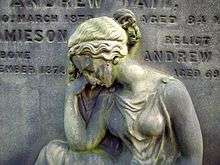
- Henrie Nisbet of Dean (died 1592), buried beneath the church
- John Napier (1550–1617) of Merchiston, inventor of logarithms, is buried in an underground vault on the north side of the church (reburied after destruction of the kirkyard of St Giles to build Parliament House)[8]
- Rev. David Williamson (1636–1706), known in Scots songs as "Dainty Davie". He was ousted from the church in 1665 as a Covenanter. He then served as a captain on the rebel side at the Battle of Bothwell Bridge (1679). He was restored as minister of St. Cuthberts in 1689 and then rose to be Moderator of the General Assembly of the Church of Scotland in 1702.
- Charles Darwin (1758–1778), uncle of the naturalist Charles Darwin, was a talented medical student but fell ill and was buried in the Duncan family vault at the Chapel of Ease on the South side of the city, now known as the Buccleuch Parish Church Burying Ground.[9]
- Sir James Rocheid of Inverleith (1715–1787) (within the church)
- Alexander Gordon, Lord Rockville (1739–1792)
- Alexander Murray, Lord Henderland (1736–1795), and his son, John Murray, Lord Murray (1778–1858), a huge monument north of the church.
- James Erskine, Lord Alva (1722–1796)
- John Cunningham, 15th Earl of Glencairn (1749–1796)
- Cosmo Gordon of Cluny FRSE (1736-1800) politician and co-founder of the Royal Society of Edinburgh in 1783
- Rev James MacKnight DD (1721–1800), religious author and Moderator of the General Assembly of the Church of Scotland in 1769
- Alexander Hamilton (Scottish physician) FRSE (1739-1802) and his son James Hamilton (Scottish physician) FRSE (1767-1839) both Professors of Medicine and Midwifery at Edinburgh University
- Rev William Paul (1754–1802), Chaplain in Ordinary to George III (in church)
- Sir John Ogilvy of Inverquharity (1722-1802)
- Thomson Bonar (1739–1814), co-founder of Encyclopaedia Britannica
- Richard Crichton (1771–1817), architect
- Adam Rolland of Gask (1734-1819), judge, and his grandson James Rolland
- Thomas Morison (1761–1820), builder of large sections of the Second New Town (north of Queen Street Gardens) and founder of Morison's Academy in Crieff.
- Dr Henry Dewar (1771–1823)
- Sir Henry Raeburn (1756–1823), artist
- Robert Archibald Smith (1780–1829), composer
- Rev Andrew Mitchell Thomson DD (1779–1831)
- Thomas Allan (1777–1833), mineralogist
- George Watson (1767–1837), RSA artist, with his son William Smellie Watson (1796–1874), also an artist
- Rev Prof George Paxton (1762–1837)
- Mrs Anne Grant (1755–1838), poet and author
- Rev John Jamieson DD FRSE (1759–1838), antiquarian
- Alexander Nasmyth (1758–1840), artist, architect, and inventor. His most notable painting is the much-copied portrait of Robert Burns. His son, James Nasmyth was also a prolific inventor, most famous for the steam hammer. His other son, Patrick Nasmyth continued the family line as an artist of note.
- John Abercrombie (physician) (1780–1844)
- Rev David Dickson (1780–1842)
- Sir Richard Honyman (1787–1842)
- Rev Robert Murray McCheyne (1813–1843)
- James Stevenson RSA, artist (1780–1844)
- George Meikle Kemp (1795–1844), master joiner, self-taught architect and designer of the Scott Monument.
- Rev David Welsh (1793–1845)
- Admiral James Haldane Tait (1771–1845)
- Andrew Combe (1797–1847), phrenologist
- John Stark FRSE (1779–1849), natural history author and printer and his son Dr James Stark FRSE (1811–1890)
- Rev Cpt James Haldane (1768–1851)
- Patrick Robertson, Lord Robertson (1798–1855)
- William Home Lizars (1788–1859), engraver
- Thomas De Quincey (1785–1859), author of Confessions of an English Opium-Eater. An addict himself, he was an acknowledged influence on many later authors, but he himself has now slipped from fame. Of those crediting De Quincey with influencing them probably the most notable is Edgar Allan Poe.
- Rev Dr Henry Grey (1778–1859)
- Thomas Stewart Traill (1781–1862)
- William Tait (publisher) (1793-1864)
- James Pillans (1778–1864), educator
- James Frederick Ferrier (1808–1864), first epistemologist.
- George Aikman (1788–1865), engraver
- William Borthwick Johnstone RSA (1804–1865), first Keeper of the National Gallery of Scotland
- John Marshall, Lord Curriehill (1794–1868), law lord
- Elizabeth C. Clephane (1830–1869), hymnwriter
- William Penney, Lord Kinloch (1801–1872), law lord
- James Craufurd, Lord Ardmillan (1804–1876), law lord
- Dr Peter David Handyside FRSE (1808-1881), anatomist
- David Rhind (1808–1883), architect
- Duncan McLaren (1800–1886) MP and Lord Provost (with his son Walter McLaren MP (1853–1912))
- William Fettes Pitcairn (d.1891), author
- Robert Traill Omond FRSE (1858–1914), physicist and geologist
- Sir Donald Crawford (1837–1919)
- Walter Biggar Blaikie (1847–1928), engineer, historian and astronomer
- Mabel Dawson RSW (1887–1965), artist
- The heart of Canadian sculptor Robert Tait McKenzie.
Ministers
Current ministers
As of Easter Day 2016, the parish is vacant. The previous minister, The Reverend David W Denniston, was minister from 2008, and was previously minister of Perth: North. Mr Denniston had also served in ministries in Ruchazie in Glasgow and Kennoway, Fife. Extra-parochial service had included convenership of the Assembly Council in 2004–2005, and he also served as an observer on the “Church Without Walls”, Special Commission.
During the current vacancy, the ministry team at St Cuthbert’s is led by the Interim Moderator, The Reverend John Cowie, minister of Stockbridge Parish Church. The Reverend Suzie Stark is the Locum Minister, and The Reverend Charles Robertson, formerly minister at the Canongate Kirk, Edinburgh also assists.
Notable previous ministers
- Rev Robert Pont (1525–1606), clergyman and judge
- Rev David Williamson (1636–1706), Covenanter, buried in the central vaults, towards the south end
- Rev William Paul (1755–1803) monument in upper stair, buried in south-west
- Rev Sir Henry Moncrieff Wellwood (1749–1827), Moderator of the Church of Scotland in 1785 – buried on the north wall of the north section of the graveyard.
- Rev John Paul (1795–1873), nephew of Moncrieff Wellwood, grandson of William Paul, monument by William Brodie next to pulpit. Buried in the south-west with William Paul. The monument was erected by his son James Balfour Paul.
- Rev David Dickson, buried in the central vaults towards the church
Through the 20th century many notable ministries were exercised in St Cuthbert’s including :
- The Reverend White Anderson
- The Reverend Tom Cuthell – During the 31-year ministry of Tom Cuthell, a significant healing ministry was developed which continues to this day.
- The Reverend David Denniston
- The Reverend George MacLeod
- The Reverend Peter Neilson – It was also in the time of Tom Cuthell’s ministry that Reverend Peter Neilson served as associate and who convened an important special commission set up by the General Assembly of the Church of Scotland whose eventual report (often entitled "Church Without Walls") had – and continues to exercise – a considerable influence on the thinking and development of the Church of Scotland in the early 21st century.
- The Very Reverend Leonard Small – Moderator of the General Assembly of the Church of Scotland, 1966–67
Regular services
Sundays
| SUNDAYS | ||
| 9.30am | Holy Communion | Memorial Chapel |
| 11.00am | Morning Worship
(Sundays excluding last Sunday of month) |
Main Sanctuary with the choir and organ |
| 11.00am | Holy Communion
(last Sunday of the month) | |
| 6.00pm | Evening Worship | Memorial Chapel |
| THURSDAYS | ||
| 1.00pm -
1.15pm |
Lunchtime Prayer Service | Memorial Chapel |
Bells
The staged tower contains a peal of 10 bells by Taylor of Loughborough hung for change ringing. They are in the key of E.
Ringing practices are held on Tuesday nights. Ringing for Sunday service is from 10:20 to 11:00 am.
Organ and organist
Mr Graham D Maclagan BMus(Hons) PGDE is currently the interim director of music.
Although St Cuthbert's was the mother church of no less than eight parish churches established during 1756–1869, it was the last parish church in the city to have a pipe organ.
Built in 1899 by Robert Hope-Jones of Birkenhead, the organ was a gift of the Gorgie MP, Robert Cox. St Cuthbert's first organist was John W. Cowie, and the original instrument was installed in two chambers on either side of the chancel.
When the internal fabric of the church was redecorated in 1928, the organ was restored and improved. Most of the 1899 pipe-work was re-incorporated to provide a summary of 29 speaking stops, 2 tremulants and 19 couplers, with a new electro-pneumatic action and the original four-manual console (keyboards) as before.
During 1956–57, the organ was completely reworked, with a number of tonal additions, and rebuilt by J. W. Walker & Sons Ltd. The Great, Swell, Solo and Pedal were moved to the North Transept Gallery and provided with new case work designed by Messrs Ian G. Lindsay & Partners, Architects of Edinburgh.
The choir organ was re-sited in the upper north choir chamber in the original case work. The all-electric draw-stop console was placed opposite here, in the former solo chamber, and the original case work removed. The organ had 65 speaking stops and 18 couplers. It was re-dedicated by the Very Rev Charles Laing Warr on Palm Sunday 1957, and a recital was given by William O. Minay, organist and choirmaster from 1946 to 1975.
After forty years of musical service the organ was again in need of attention, and Walker & Sons were called in for major reconstruction and improvement in 1997–98. Thanks to the legacies of two elders in St Cuthbert's, Janet Lusk and John Shepherd, the restoration was carried out to the specification of Colin Tipple – a previous organist – in consultation with David Sanger.
The opportunity was taken to replace the old choir organ with an entirely new organ which includes great, swell and pedal divisions playable from a completely revised, detached all-electric four-manual console. These divisions can be combined with the main organ in the north transept gallery. The new section not only provides accompaniment for the church choir but can be used as a separate instrument for services held in the chancel.
Both organ cases were retained without alteration. The chancel case – designed by Hippolyte Blanc, the architect of the church – only needed cleaning, while the north gallery case was restored and repolished. Between them they contain 114 display (visible) pipes. The reconstructed organ has 67 speaking stops, 3 tremulants, 20 couplers and 3 piston couplers, making a total of 93 registers.
Other organisations
Edinburgh City Centre Churches Together
St Cuthbert's is one of three churches which form Together, an ecumenical grouping in the New Town of Edinburgh. The others are St Andrew's & St George's West and St John's.[10]
Edinburgh Festival Fringe
The church is also used as a venue during the Edinburgh Festival Fringe.[11]
See also
- List of Church of Scotland parishes by presbytery
References
- 1 2 http://maps.nls.uk/view/74400071
- ↑ "St Cuthbert's Website : The Kirk – 18th Century History". Retrieved 17 July 2011.
- ↑ "Site Record for Edinburgh, 33 Chapel Street, Buccleuch Parish Church Buccleuch Street And Chapel Street, Buccleuch Parish Church Prints". Royal Commission on the Ancient and Historical Monuments of Scotland. 2011. Retrieved 17 July 2011.
- ↑ "Listed Building Report". Chapel Street, former Buccleuch Parish Church. Historic Scotland. 8 August 2011. Retrieved 2011-08-08.
- ↑ City of Edinburgh Council: Planning records 2013
- ↑ Buildings of Scotland: Edinburgh , by Gifford McWilliam and Walker
- 1 2 3 Parish Records
- ↑ Monuments and monumental inscriptions in Scotland: The Grampian Society, 1871
- ↑ Fulton, JF.; Fulton, JF.; Darwin, C. (Dec 1999). "Charles Darwin (1758–1778) and the history of the early use of digitalis. 1934.". J Urban Health. 76 (4): 533–41. doi:10.1007/bf02351508. PMC 3456699
 . PMID 10609600. PDF
. PMID 10609600. PDF - ↑ Together Trust
- ↑ "St Cuthbert's Parish Church". Edinburgh Guide. Retrieved 23 Mar 2016.
- Gifford, John; McWilliam, Colin; Walker, David; Wilson, Christopher, The Buildings of Scotland – Edinburgh, Penguin Books, London, 1984, pp. 275–277. ISBN 0-14-071068-X
- "St. Cuthbert's Parish Church – Edinburgh, Scotland". Sacred Destinations. Retrieved 2009-05-27.
Coordinates: 55°56′59″N 3°12′19″W / 55.9496°N 3.2052°W